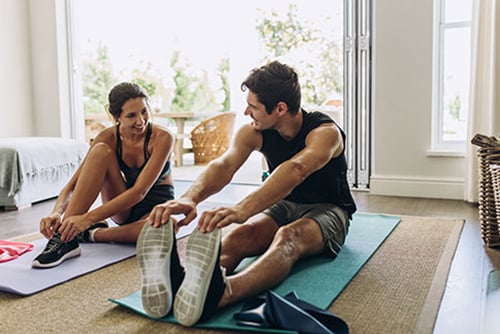Keeping fit whilst working from home
There are specific challenges that come with working from home. In this article we are encouraged to be prepared, proactive and solution-focused!
Benestar (partner of Zurich Group and EAP provider) | 28th Apr 2020

Besides the usual Working From Home checklists that we should be adhering to, there are some essential things to consider:
Be kind to your body.
It will notice the difference. Unless your home office is an exact replica of your office work station, your body will experience a new seating position that it is not used to. We spend a lot of time at our work desks. When you begin working from home long-term at a new desk and set-up, your body will notice the difference. Even little things, like reaching for a phone or mug at your new desk, may trigger some discomfort at first.
Be mindful of how your body feels.
Set reminders to check on your posture and how the body is feeling throughout the day, paying particular attention to back, neck and wrist aches. If available, use technology like your apps on your Apple Watch or phone to set yourself regular reminders. In my home, I’ve also enlisted Google Home to set an hourly alarm to remind me that I need to get up and move my body. If something doesn’t feel right, be a detective … look around, and try to make the appropriate changes to your home environment.
Set yourself up for success.
Follow the advice of your organisation’s Working From Home guidelines. They have done the research for you. Be creative in setting up your home office to make things ergonomically sound, e.g. identify where in your home you are the most likely to be undisturbed, use boxes to safely prop up monitors to sit at a comfortable height, and organise good lighting. Identify the most comfortable chair you have, and consider purchasing a second-hand ergonomic office chair, which is height-adjustable and provides lumbar support.
Follow a regular schedule and maintain the same routines each workday.
Wake up at a regular time, attend to your hygiene routine as you usually would if you were preparing to go into the office.
Plan regular breaks away from the home office desk.
Work at your usual pace. It’s easy to fall into the trap of doing too little (because you think you have the time later) or too much (because the work is right in front of you). Writing down your schedule or using Outlook Calendar for tasks is an excellent way to organise yourself and to keep yourself accountable.
Dress for success.
Some people may find it useful wearing their “work clothes” to get into “work mode”. But you could also try something a bit different and change into so-called activewear, which is generally more comfortable and may even encourage you to be physically active around the house. If you wear your training shoes, you may also be encouraged to go for a brisk walk around the neighbourhood at lunchtime! Only you can make the right decision about what to wear at home, by asking yourself “Which clothes will allow me to be productive throughout the day?” You do you.
Calorie counting.
If you’re anything like me, working from home provides an all too tempting and convenient close proximity to the kitchen cupboards and fridge. Be mindful that you may not be as physically active as you would be when commuting back and forth to the office. With the current corona outbreak, gyms have also been instructed to close, so your physical activity may be limited over the coming weeks and months.
A simple way to monitor food intake is by using a fitness and calorie app such us the MyFitnessPal app. From personal experience, I was able to manage my kJ intake over the last 12 months and to lose approximately 20kg. These apps allow you to scan barcodes of your favourite foods, and has a catalogue of food items and meals we eat regularly. Before making any drastic changes to food intake; please consult a trained professional.
Regular physical activity.
This does not mean you need to work up a sweat! Many activities can be done indoors. When getting up from your seat, plan activities that get the body moving. Stretching is a great way to relieve tension in the muscles. It’s also essential to get the joints moving, and there are some great online resources available. Again, set up your workout space and if you are unfamiliar with an activity, take it slowly and build yourself up.
Another suggestion for those who have a streaming device such as Apple TV or Google Chrome (or even a smart-phone) is to search for low-impact workouts on YouTube and the like, and to stream content directly to your TV. Why not schedule a 20-minute exercise over your lunchtime? There are also some great yoga channels to get the body moving.
Finally be proactive and solution-focused.
- If something doesn’t feel “right”, take the time to step away and reassess.
- Connect with colleagues who can offer their perspective and use advice that suits your situation.
- There are no right or wrong suggestions, just ideas that could lead to the best solution for you.
If you are unfamiliar with how to exercise at home or would like further nutritional information, please seek the advice of trained professionals.
This is a free resource curated by Zurich International to provide support to employers and their employees, wherever they are in the world.
Please favourite this site and check back regularly for new well-being content
If you feel others will benefit please share: